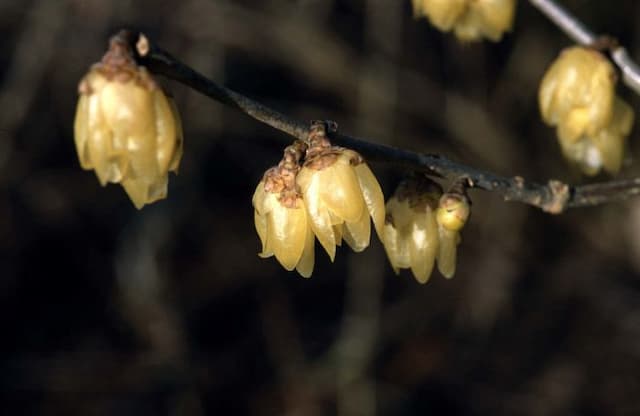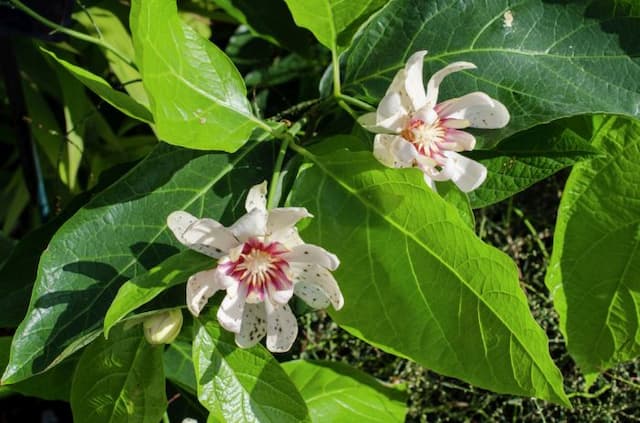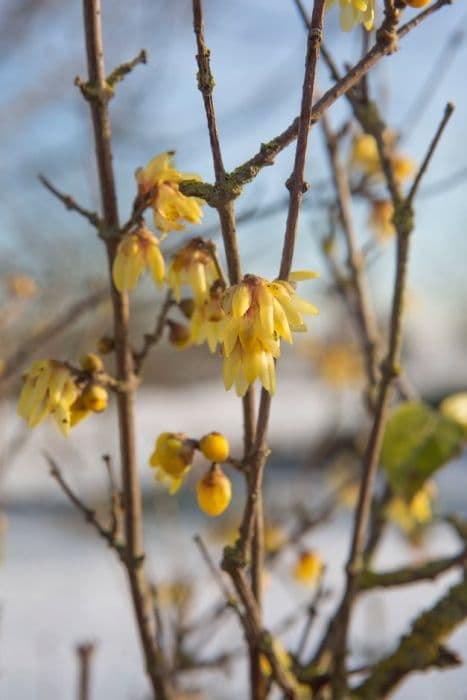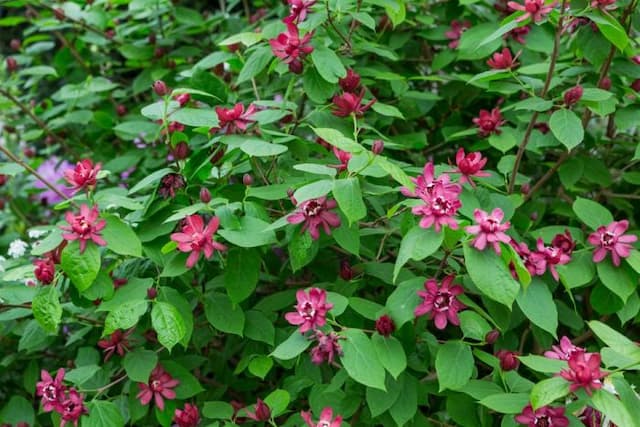Wintersweet Chimonanthus praecox 'Grandiflorus'

ABOUT
The plant commonly known as wintersweet is a deciduous shrub that is well-regarded for its mid-winter blooms. The 'Grandiflorus' cultivar of wintersweet is notable for its particularly large flowers. These blossoms are waxy and translucent, and tend to be a pale yellow color, often with a purplish center. They exude a rich, spicy fragrance that is especially welcome during the colder months when few other plants are in bloom. The leaves of the wintersweet are simple and lanceolate, meaning they are shaped like a lance, with a broad base that tapers to a point. In terms of color, the leaves are typically a medium to dark green hue and have a smooth, leathery texture. They provide a lush backdrop to the striking flowers. The branches of this shrub are arranged in a somewhat open, spreading fashion, giving the wintersweet an overall graceful appearance. In the non-flowering season, the plant's structure contributes to its attractiveness, with the bare branches presenting a pleasing silhouette against the winter sky. The fruits of the wintersweet are inconspicuous, with dry capsules that contain the seeds of the plant. These capsules usually go unnoticed amidst the foliage and are not a significant aspect of the plant's ornamental appeal. Overall, the 'Grandiflorus' cultivar of wintersweet is particularly cherished for its delightful winter flowers, contrasting beautifully against the cold-weather backdrop and offering a burst of color and fragrance when most other plants lie dormant.
About this plant
 Names
NamesFamily
Calycanthaceae
Synonyms
Wintersweet, Japanese Allspice, Winter Bloom
Common names
Chimonanthus fragrans 'Grandiflorus', Meratia praecox 'Grandiflorus', Meratia praecox f. grandiflora.
 Toxicity
ToxicityTo humans
The most common common name of Chimonanthus praecox 'Grandiflorus' is wintersweet. Wintersweet is not widely known for its toxicity to humans. However, as with many plants, it is generally not recommended to ingest any parts of wintersweet because it is not a food item. Consuming plant material that is not classified as edible can lead to gastrointestinal discomfort or other adverse effects due to the presence of saponins and other compounds that could be irritating to the digestive system if ingested. Nevertheless, there is no significant data indicating severe poisoning or life-threatening consequences directly associated with the ingestion of wintersweet.
To pets
The most common common name of Chimonanthus praecox 'Grandiflorus' for pets is wintersweet. There is limited information on the toxicity of wintersweet specifically to pets such as cats and dogs, but it is not commonly listed among plants that are known to be toxic to pets. Although wintersweet might not be specifically toxic, ingestion of non-food plants by pets can lead to gastrointestinal upset, including symptoms like vomiting and diarrhea. It's always best to prevent pets from ingesting any part of decorative plants, as individual animals might have sensitivities, and the potential for mild toxicity from unknown plant compounds always exists.
 Characteristics
CharacteristicsLife cycle
Perennials
Foliage type
Deciduous
Color of leaves
Green
Flower color
Yellow
Height
10-15 feet (3-4.5 meters)
Spread
8-12 feet (2.4-3.6 meters)
Plant type
Shrub
Hardiness zones
7
Native area
China
Benefits
 General Benefits
General Benefits- Ornamental Value: Chimonanthus praecox 'Grandiflorus', commonly known as wintersweet, is highly valued for its ornate, pale yellow flowers that add aesthetic appeal to winter gardens.
- Fragrance: The blooms of the wintersweet emit a strong, sweet fragrance that can scent an entire garden, providing olfactory pleasure during the cold season.
- Winter Blooming: As its common name suggests, wintersweet flowers in the winter, providing color and interest during a season when most plants are dormant.
- Attracts Wildlife: The flowers provide a source of nectar and attract pollinators such as bees, which are active on warm winter days.
- Long-Lived: Wintersweet is a long-lived shrub, which can provide years of enjoyment once established in the landscape.
- Hardiness: This plant is known for its hardiness and can withstand cold temperatures, making it suitable for a variety of climates.
- Low Maintenance: Wintersweet requires minimal care once established, making it an ideal choice for gardeners of all skill levels.
- Cut Flowers: The branches with flowers can be cut and brought indoors, where their fragrance can be enjoyed in flower arrangements.
 Medical Properties
Medical Properties- This plant is not used for medical purposes.
 Air-purifying Qualities
Air-purifying QualitiesThis plant is not specifically known for air purifying qualities.
 Other Uses
Other Uses- Winter sweet branches are sometimes used as a natural clothes freshener when hung in wardrobes or placed in drawers, imparting their fragrance to clothing and linens.
- The fragrant flowers of Chimonanthus praecox can be used in potpourris, adding a pleasant aroma to a mixture of dried herbs and flowers for long-lasting scent.
- Essential oil extracted from winter sweet flowers is occasionally used in perfume and aromatherapy for its unique and appealing scent.
- Winter sweet is used in traditional Japanese flower arranging, known as Ikebana, as it provides both visual beauty and fragrance to the arrangements.
- The plant's robust stems can be used as natural supports for other garden plants, such as climbing vines or weak-stemmed flowers.
- Dried Chimonanthus praecox petals can be used to make aromatic bookmarks, by slipping them into a laminating pouch and sealing, they release a subtle scent when used in books.
- Floral water infused with winter sweet flowers can be used as a linen spray for sheets and pillowcases, offering a soothing fragrance at bedtime.
- Pressed winter sweet flowers are sometimes used in the art of botanical paper making, adding a fragrant and decorative element to handmade papers.
- Winter sweet wood is occasionally carved into small objects or ornaments, as it is sufficiently hard and can hold fine details.
- Winter sweet petals can be added to bathwater for a fragrant and relaxing experience, as the petals disperse their scent when steeped in warm water.
Interesting Facts
 Feng Shui
Feng ShuiThe Wintersweet is not used in Feng Shui practice.
 Zodiac Sign Compitability
Zodiac Sign CompitabilityThe Wintersweet is not used in astrology practice.
 Plant Symbolism
Plant Symbolism- Promising future - The blooms of Chimonanthus praecox also known as wintersweet, emerge during the late winter, symbolizing hope and the promise of the coming spring.
- Endurance - Wintersweet's ability to thrive and bloom in the coldest season is often associated with stamina and the ability to endure hardships.
- Fragrance of memories - The strong, pleasant fragrance of wintersweet flowers is thought to evoke memories, symbolizing nostalgia and the past.
- Rarity and value - As Chimonanthus praecox 'Grandiflorus' is not commonly seen in every garden, it can symbolize uniqueness and the value of rare beauty.
- Renewal - Just as this plant announces the end of winter, it is associated with the concept of renewal and starting afresh.
 Water
WaterThe Wintersweet should be watered thoroughly, allowing the water to soak in rather than runoff. During the growing season, ensure the soil is kept moist but not waterlogged, watering approximately once a week with about 1-2 gallons per plant, depending on weather conditions. In winter, reduce watering to every two to three weeks, relying on the same amount, as the plant requires less moisture when dormant. Always check the soil before watering; it should be dry an inch below the surface for younger plants and a few inches for established ones. Overwatering can be detrimental, so err on the side of caution, especially in cooler months.
 Light
LightWintersweet thrives in full sun to partial shade. The ideal location offers morning sunlight with some afternoon shade, especially in hotter climates, to prevent scorching. It can also adapt to dappled shade under open canopy trees, which makes it versatile in a garden setting. Avoid deep shade, as it will reduce the abundance of fragrant blooms the plant is known for.
 Temperature
TemperatureWintersweet prefers a temperate climate with cool to moderate temperatures, performing best between 40 to 60 degrees Fahrenheit. It is quite cold-hardy and can withstand temperatures as low as -10 degrees Fahrenheit, making it suitable for many temperate regions. However, extreme heat above 80 degrees Fahrenheit can stress the plant, so it should be protected from the intense afternoon sun during peak summer.
 Pruning
PruningPruning Wintersweet encourages healthy growth and flowering. Prune right after flowering, typically in late winter or early spring, by removing dead or weak branches and shaping the plant. Thinning out dense growth every few years helps to improve air circulation. It's best to prune the plant annually, but avoid heavy pruning as this could reduce the number of blooms in the following season.
 Cleaning
CleaningAs needed
 Soil
SoilWintersweet prefers well-draining soil enriched with organic matter; a mix of two parts loam, one part peat, and one part sand works well. The ideal pH for this soil mixture should be slightly acidic to neutral, around pH 6.0 to 7.0.
 Repotting
RepottingWintersweet does not require frequent repotting; it should be repotted every 2-3 years or when it has outgrown its current container. Spring is the best time to repot this plant.
 Humidity & Misting
Humidity & MistingWintersweet prefers moderate to high humidity levels but is quite adaptable. Aiming for a humidity level of around 40-60% would be ideal for this plant.
 Suitable locations
Suitable locationsIndoor
Place Wintersweet in bright, indirect light indoors and ensure good air circulation.
Outdoor
Plant Wintersweet in a sunny to partially shaded spot with shelter from harsh winds.
Hardiness zone
6-9 USDA
 Life cycle
Life cycleChimonanthus praecox 'Grandiflorus', commonly known as winter sweet, begins its life cycle as a seed, which germinates in late spring after experiencing cold stratification. Following germination, the seedling develops into a juvenile plant with a branching structure and foliage. After several years, the juvenile plant matures into an adult capable of flowering, usually during winter or early spring, when it produces fragrant, yellow blooms often with a purple center. Following pollination, these flowers develop into capsules that contain seeds, which are dispersed by wind or wildlife. Over the summer, the plant enters a period of vegetative growth, where it focuses on developing leaves and stems while storing energy for the next flowering season. As the plant ages, it can continue this cycle for many years, flowering annually, though older plants may require pruning to maintain vigour and encourage blooming.
 Propogation
PropogationPropogation time
Spring to early summer
Propogation: For the wintersweet (Chimonanthus praecox 'Grandiflorus'), the most popular method of propagation is by semi-hardwood cuttings. This is usually done in late summer. Semi-hardwood cuttings are taken from the current season's growth that has begun to mature; they should be about 4 to 6 inches long (approximately 10 to 15 centimeters). The lower leaves are removed and the cut end is often dipped in a rooting hormone to encourage root development. The cutting is then placed in a well-draining potting mix, and kept under high humidity and indirect light until roots have formed, which can take several weeks.




